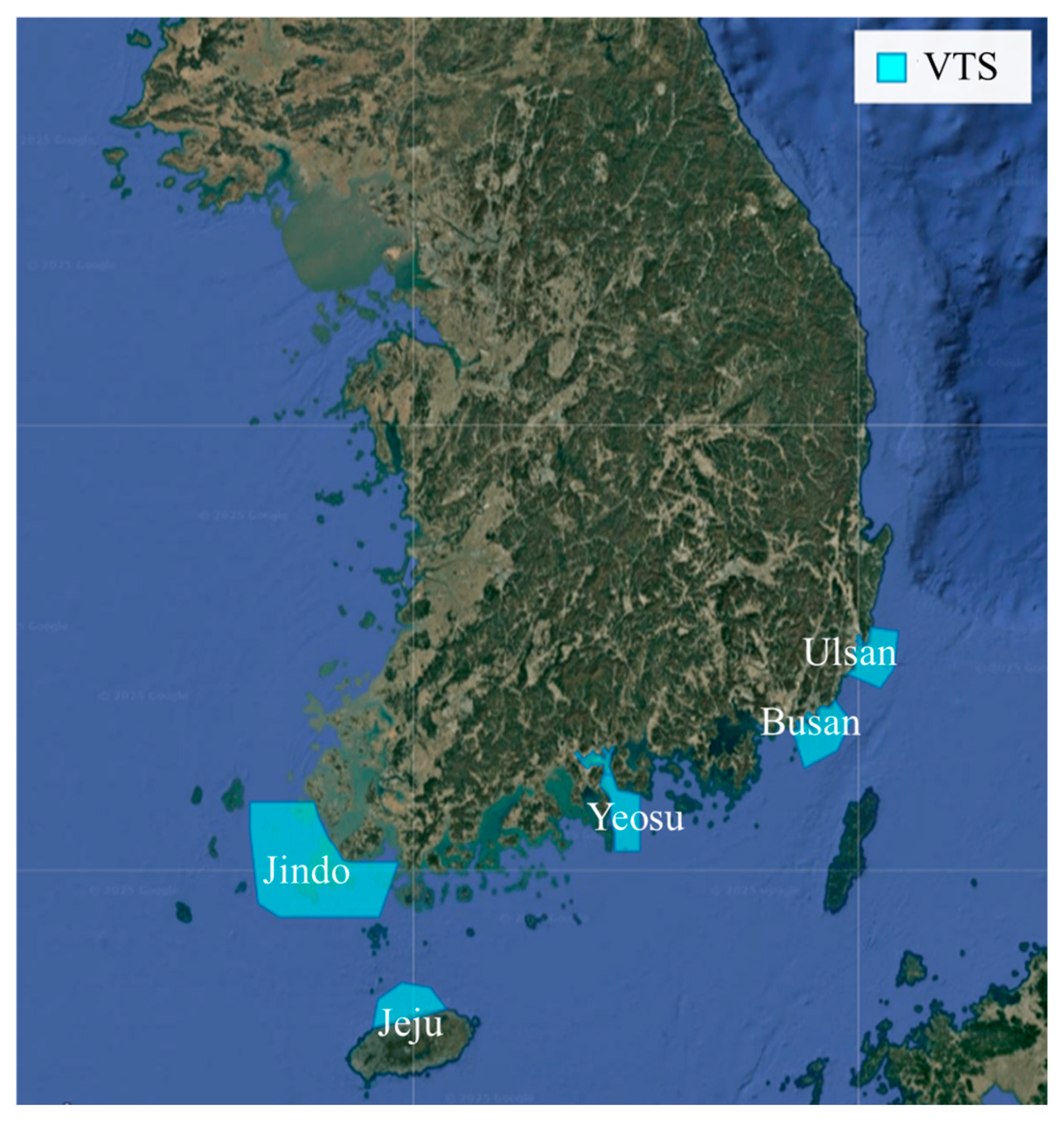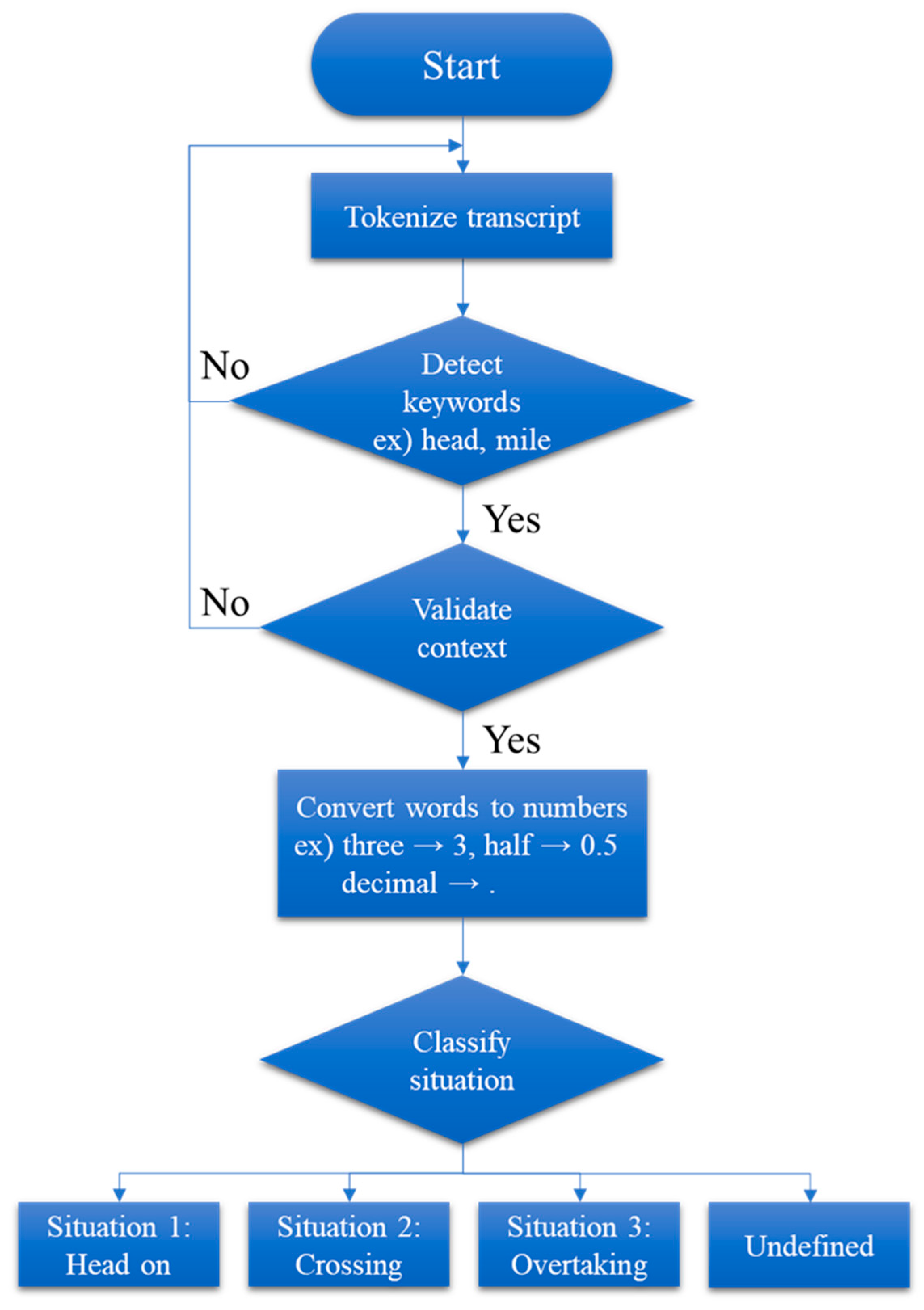Speech Recognition-Based Analysis of Vessel Traffic Service (VTS) Communications for Estimating Advisory Timing
Abstract
1. Introduction
2. Materials and Methods
2.1. Data Collection and Study Design
2.2. Speech Recognition and Transcription
2.3. Natural Language Processing and Situation Classification
3. Results
3.1. Extracted Transcripts for Analysis
3.2. Distance Analysis by Encounter
4. Discussion
5. Conclusions
Author Contributions
Funding
Institutional Review Board Statement
Informed Consent Statement
Data Availability Statement
Conflicts of Interest
References
- Ducruet, C. The geography of maritime networks: A critical review. J. Transp. Geogr. 2020, 88, 102824. [Google Scholar] [CrossRef]
- Sharma, A.; Kim, T.E. Exploring technical and non-technical competencies of navigators for autonomous shipping. Mar. Policy Manage. 2022, 49, 831–849. [Google Scholar] [CrossRef]
- Hetherington, C.; Flin, R.; Mearns, K. Safety in shipping: The human element. J. Saf. Res. 2006, 37, 401–411. [Google Scholar] [CrossRef] [PubMed]
- Wróbel, K. Searching for the origins of the myth: 80% human error impact on maritime safety. Reliab. Eng. Syst. Saf. 2021, 216, 107942. [Google Scholar] [CrossRef]
- Sánchez-Beaskoetxea, J.; Basterretxea-Iribar, I.; Sotés, I.; Maruri Machado, M.M. Human error in marine accidents: Is the crew normally to blame? Mar. Transp. Res. 2021, 2, 100016. [Google Scholar] [CrossRef]
- Hughes, T. When is a VTS not a VTS? J. Navig. 2009, 62, 439–442. [Google Scholar] [CrossRef]
- Moreno, F.C.; Roca Gonzalez, J.; Suardíaz Muro, J.; García Maza, J.A. Relationship between human factors and a safe performance of vessel traffic service operators: A systematic qualitative-based review in maritime safety. Saf. Sci. 2022, 155, 105892. [Google Scholar] [CrossRef]
- Praetorius, G.; Hollnagel, E.; Dahlman, J. Modelling Vessel Traffic Service to understand resilience in everyday operations. Reliab. Eng. Syst. Saf. 2015, 141, 10–21. [Google Scholar] [CrossRef]
- Yang, D.; Wu, L.; Wang, S.; Jia, H.; Li, K.X. How big data enriches maritime research—A critical review of Automatic Identification System (AIS) data applications. Transp. Rev. 2019, 39, 755–773. [Google Scholar] [CrossRef]
- Filipiak, D.; Węcel, K.; Stróżyna, M.; Michalak, M.; Abramowicz, W. Extracting maritime traffic networks from AIS data using evolutionary algorithm. Bus. Inf. Syst. Eng. 2020, 62, 435–450. [Google Scholar] [CrossRef]
- Yan, Z.; Xiao, Y.; Cheng, L.; He, R.; Ruan, X.; Zhou, X.; Li, M.; Bin, R. Exploring AIS data for intelligent maritime routes extraction. Appl. Ocean Res. 2020, 101, 102271. [Google Scholar] [CrossRef]
- Forti, N.; Millefiori, L.M.; Braca, P. Unsupervised extraction of maritime patterns of life from Automatic Identification System data. In Proceedings of the OCEANS 2019—Marseille, Marseille, France, 17–20 June 2019; pp. 1–5. [Google Scholar]
- Tsou, M.C.; Hsueh, C.K. The study of ship collision avoidance route planning by ant colony algorithm. J. Mar. Sci. Technol. 2010, 18, 746–756. [Google Scholar] [CrossRef]
- Liu, Z.; Liu, J.; Zhou, F.; Liu, R.W.; Xiong, N. A robust GA/PSO-hybrid algorithm in intelligent shipping route planning systems for maritime traffic networks. J. Internet Technol. 2018, 19, 1635–1644. [Google Scholar]
- Lamm, A.; Hahn, A. Detecting maneuvers in maritime observation data with CUSUM. In Proceedings of the 2017 IEEE International Symposium on Signal Processing and Information Technology (ISSPIT), Bilbao, Spain, 18 December 2017; pp. 122–127. [Google Scholar]
- Zhang, S.K.; Shi, G.Y.; Liu, Z.J.; Zhao, Z.W.; Wu, Z.L. Data-driven based automatic maritime routing from massive AIS trajectories in the face of disparity. Ocean Eng. 2018, 155, 240–250. [Google Scholar] [CrossRef]
- International Maritime Organization. IMO Model Course 3.17. In Maritime English; International Maritime Organization: London, UK, 2010. [Google Scholar]
- Wang, Y.; Zhang, J.; Liu, R.W. Deep learning for automatic speech recognition in maritime VHF communication. J. Mar. Sci. Eng. 2021, 9, 411. [Google Scholar]
- Chen, P.; Huang, Y.; Mou, J.; van Gelder, P.H.A.J.M. Ship collision candidate detection method: A velocity obstacle approach. Ocean Eng. 2018, 170, 186–198. [Google Scholar] [CrossRef]
- Kim, J.S. A basic study on the VTS operator’s minimum safe distance. J. Korean Soc. Mar. Environ. Saf. 2013, 19, 476–482. [Google Scholar] [CrossRef]
- Park, S.W.; Park, Y.S. A Basic Study on Development of VTS Control Guideline based on ship’s operator’s Consciousness. J. Navig. Port Res. 2016, 40, 105–111. [Google Scholar] [CrossRef]
- International Maritime Organization. Convention on the International Regulations for Preventing Collisions at Sea (COLREG), 1972; IMO: London, UK, 1972. [Google Scholar]
- Amodei, D.; Ananthanarayanan, S.; Anubhai, R.; Bai, J.; Battenberg, E.; Case, C.; Zhu, Z. Deep speech 2: End-to-end speech recognition in english and mandarin. In Proceedings of the International Conference on Machine Learning, New York, NY, USA, 19–24 June 2016; pp. 173–182. [Google Scholar]
- Baevski, A.; Zhou, Y.; Mohamed, A.; Auli, M. wav2vec 2.0: A framework for self-supervised learning of speech representations. Adv. Neural Inf. Process. Syst. 2020, 33, 12449–12460. [Google Scholar]
- Radford, A.; Kim, J.W.; Xu, T.; Brockman, G.; McLeavey, C.; Sutskever, I. Robust speech recognition via large-scale weak supervision. In Proceedings of the 40th International Conference on Machine Learning, Honolulu, HI, USA, 23–29 July 2023; pp. 28492–28518. [Google Scholar]






| Encounter Type | Sample of Sentences and Text-to-Number Conversion | |
|---|---|---|
| Head-on | Ahead of you two nautical mile. → 2.0 nm | |
| 전방 이 마일 → 2.0 nm | ||
| Crossing | Stand-on | On your port bow distance three point six mile outbound vessel → 3.6 nm |
| 좌현 선수 삼점 육 마일에 출항선이 있습니다. → 3.6 nm | ||
| Give-way | Inbound vessel hanyu dream your starboard bow two mile pass port to port. → 2.0 nm | |
| 우현 선수 이 마일에 있는 입항선과 좌현대 좌현 하십시오. → 2.0 nm | ||
| Overtaking | Astern from you, I will overtake on your port side. | |
| 귀선 선미에서 좌현으로 추월하겠습니다. | ||
| VTS Area | Labeling Data Total Duration | Number of VTS Advisory Transmissions |
|---|---|---|
| Busan Port VTS | 19.1 h | 24 |
| Ulsan Port VTS | 91.4 h | 233 |
| Yeosu Port VTS | 37.5 h | 27 |
| Jeju Port VTS | 110.9 h | 146 |
| Jindo Coastal VTS | 75.3 h | 435 |
| Total | 334.2 h | 865 |
| VTS Area | Encounter Type | Number of VTS Advisory Transmissions | Mean Advisory Distance(nm) |
|---|---|---|---|
| Busan Port VTS | Head-on | 7 | 2.3 |
| Crossing (stand-on vessel) | 13 | 2.8 | |
| Crossing (give-way vessel) | 4 | 1.7 | |
| Ulsan Port VTS | Head-on | 53 | 3.1 |
| Crossing (stand-on vessel) | 79 | 2.7 | |
| Crossing (give-way vessel) | 101 | 3.0 | |
| Yeosu Port VTS | Head-on | 15 | 2.3 |
| Crossing (stand-on vessel) | 6 | 3.2 | |
| Crossing (give-way vessel) | 6 | 2.9 | |
| Jeju Port VTS | Head-on | 66 | 2.6 |
| Crossing (stand-on vessel) | 35 | 2.3 | |
| Crossing (give-way vessel) | 45 | 2.8 | |
| Jindo Coastal VTS | Head-on | 269 | 3.3 |
| Crossing (stand-on vessel) | 78 | 2.8 | |
| Crossing (give-way vessel) | 88 | 2.9 | |
| Total | Head-on | 410 | 3.1 |
| Crossing (stand-on vessel) | 211 | 2.7 | |
| Crossing (give-way vessel) | 244 | 2.9 |
| Encounter Type | n | Mean (nm) | SD | t | df | p |
|---|---|---|---|---|---|---|
| Head-on | 410 | 3.1 | 1.8 | 2.8 | 803.6 | 0.0048 |
| Crossing | 455 | 2.8 | 1.5 |
Disclaimer/Publisher’s Note: The statements, opinions and data contained in all publications are solely those of the individual author(s) and contributor(s) and not of MDPI and/or the editor(s). MDPI and/or the editor(s) disclaim responsibility for any injury to people or property resulting from any ideas, methods, instructions or products referred to in the content. |
© 2025 by the authors. Licensee MDPI, Basel, Switzerland. This article is an open access article distributed under the terms and conditions of the Creative Commons Attribution (CC BY) license (https://creativecommons.org/licenses/by/4.0/).
Share and Cite
Yoo, S.-L.; Kim, K.-I.; Jung, C.-Y. Speech Recognition-Based Analysis of Vessel Traffic Service (VTS) Communications for Estimating Advisory Timing. Appl. Sci. 2025, 15, 11968. https://doi.org/10.3390/app152211968
Yoo S-L, Kim K-I, Jung C-Y. Speech Recognition-Based Analysis of Vessel Traffic Service (VTS) Communications for Estimating Advisory Timing. Applied Sciences. 2025; 15(22):11968. https://doi.org/10.3390/app152211968
Chicago/Turabian StyleYoo, Sang-Lok, Kwang-Il Kim, and Cho-Young Jung. 2025. "Speech Recognition-Based Analysis of Vessel Traffic Service (VTS) Communications for Estimating Advisory Timing" Applied Sciences 15, no. 22: 11968. https://doi.org/10.3390/app152211968
APA StyleYoo, S.-L., Kim, K.-I., & Jung, C.-Y. (2025). Speech Recognition-Based Analysis of Vessel Traffic Service (VTS) Communications for Estimating Advisory Timing. Applied Sciences, 15(22), 11968. https://doi.org/10.3390/app152211968









